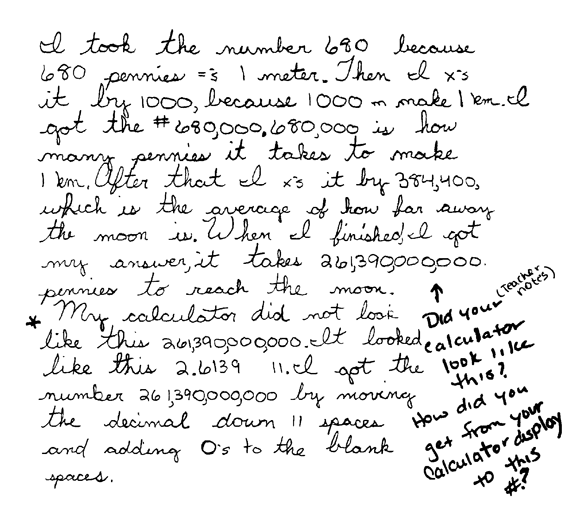Review Mary's Work. Review sample work with students so they become more familiar with the Math Practice Expectations. Explain that you are going to show them some solutions written by other students. Tell the class that they will help you provide feedback to each student so that the student can improve his or her work.
Show a display of the Mary's Work Master along with a display of the Stack Up Work Check-In: Question 3 Feedback Box Student-to-Student Master. See Figures 3 and 4. These or similar discussion prompts can be used to guide a discussion about how well Mary met the Math Practices Expectations with her work.
Select student work samples from your own classes to review and discuss.
- How did Mary solve the problem? Can you tell from her work what tools or strategies she used? (You can see that Mary used multiplication to find her answer, but it is not clear how she got her numbers. For example, where did the 700 come from? She explains that she is finding the number of pennies in a kilometer, but if the 700 is the number of pennies in a meter she needs to say that. Mary also needs to explain that she rounded the distance to the moon − 384,400 kilometers to the nearest 100,000 kilometers to get 400,000 kilometers.)
- Did Mary label her numbers to show what they mean? (Possible response: Mary did label some numbers. For example, she said there are 700,000 pennies in a kilometer. She also said that it would take 280,000,000 pennies to reach the moon. She did not label any of the other numbers.)
- Did May check the reasonableness of her solution? (Mary did not show that she checked her solution using a different strategy. One possible strategy would be to find the distance to the moon in meters (400,000 kilometers × 1000 meters = 400,000,000 meters or 400 million meters). Then she could multiply 700 pennies in one meter × 400,000,000 = 280,000,000,000 or 280 billion pennies to reach the moon.)
- How could Mary revise her explanation so it is easier for someone to understand her thinking? (Mary could include labels on all of her numbers. She could also explain were she got her numbers. For example, she could explain that she knows there are 700 pennies in a meter and since there are 1000 meters in a kilometer, 700 pennies × 1000 meters = 700,000 pennies in one kilometer. Mary should also explain how she rounded 384,400 kilometers to get 400,000 kilometers.)
Review Maria's Work. Show the display of Maria's Work Master from the Teacher Guide and the second display of the Feedback Box. See Figures 5 and 6.
After students have reviewed Maria's work, ask:
- What strategies and tools did Maria use to solve this problem? (Maria used multiplication to find her answer. She took the number of pennies that it would take to make a stack 1 meter tall and then multiplied by 1000 to find the number of pennies in a stack 1 kilometer tall (680,000 pennies). She then multiplied by 384,400. She clearly labeled this as the average distance between the Earth and moon. Maria's solution is that it takes 261,390,000,000 pennies to make a stack tall enough to reach the moon. It is unclear if Maria used any tools when she multiplied. For example, did she use a calculator?)
- Did Maria label her numbers to show what they mean? (Yes, you can easily tell what each of her numbers mean.)
- Did Maria check her solution to make sure it was reasonable? (There is no evidence that Maria checked her solution. One possible strategy for checking the reasonableness of her solution would be to estimate the number of pennies it would take to build a stack to the moon by rounding the number of pennies in a meter to 700 pennies and the number of kilometers to the moon to 400,000 kilometers. She could then multiply to find that it would take about 280,000,000,000 pennies to build a stack to the moon. Since her answer of 261,390,000,000 is close to 280,000,000,000, her answer is reasonable.)
- Was Maria's explanation written so others can understand her thinking? (Yes, Maria's explanation is clear so you can follow her thinking.)
Give students a chance to review and revise their own solutions and explanations based on what they learned from the student sample review.
There are several strategies you can use to improve student explanations.
- Review a student's written work and then have a conference discussing how solutions can be improved.
- Peers can help each other review and communicate solutions.
- Review sample student work with the class and then ask them to revise the student sample.
- Students conduct a Self Review using a set of expectations like those outlined on the Math Practices page in the Student Guide Reference section.
- Provide an outside audience to help focus student revisions. For example, tell students, “Write your explanation so your mom, dad, or sister can understand what you did.”
This lesson describes a peer review and a review of sample work, but any of the above strategies can be useful.
















